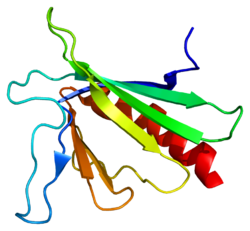
Vasodilator-stimulated phosphoprotein

1EGX, 1USD, 1USE, 2PAV, 2PBD, 3CHW740822323ENSG00000125753ENSMUSG00000030403P50552P70460NM_001008736NM_003370NM_001282021NM_001282022NM_009499NP_003361NP_001268950NP_001268951NP_033525Vasodilator-stimulated phosphoprotein is a protein that in humans is encoded by the VASP gene.1egx: SOLUTION STRUCTURE OF THE ENA-VASP HOMOLOGY 1 (EVH1) DOMAIN OF HUMAN VASODILATOR-STIMULATED PHOSPHOPROTEIN (VASP)1usd: HUMAN VASP TETRAMERISATION DOMAIN L352M1use: HUMAN VASP TETRAMERISATION DOMAIN Vasodilator-stimulated phosphoprotein is a protein that in humans is encoded by the VASP gene. Vasodilator-stimulated phosphoprotein (VASP) is a member of the Ena-VASP protein family. Ena-VASP family members contain an N-terminal EVH1 domain that binds proteins containing E/DFPPPPXD/E motifs and targets Ena-VASP proteins to focal adhesions cell membranes. In the mid-region of the protein, family members have a proline-rich region that binds SH3 and WW domain-containing proteins. Their C-terminal EVH2 domain mediates tetramerization and binds both G and F actin. VASP is associated with filamentous actin formation and likely plays a widespread role in cell adhesion and motility. VASP may also be involved in the intracellular signaling pathways that regulate integrin-extracellular matrix interactions. VASP is regulated by the cyclic nucleotide-dependent kinases PKA and PKG. Vasodilator-stimulated phosphoprotein has been shown to interact with Zyxin, Profilin 1, and PFN2.
